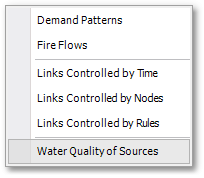The Time Simulation Source Data tab of the Time Simulation Data table is accessed by selecting Simulation Data > Simulation Tables > Water Quality of Sources.

It is a custom designed table, which assists the user to specify water quality of sources. These are used to describe the quality of source flow entering the network at a specific node, and might represent e.g. a treatment works, chlorine booster station, or an unwanted contaminant intrusion.

Up to 150 water quality source nodes may therefore be identified and specified. For each, the columns/values to be entered are:
•Node Code: The node code of the water quality source. (Click on the hand icon for spatial selection. You will be prompted at the command window to select the node on the map).
•Source Type: One of 4 types of quality sources can be selected with a drop-down list, viz. CONCEN, M.BOOSTER, F.BOOSTER or S. BOOSTER. See comments below.
•Source Concentration: For M.BOOSTER type sources, this is the mass flow per minute. For the other three types, this is the source strength in concentration units, e.g. mg/L.
•Pattern: The baseline source strength in the previous column can be made to vary over time by specifying a time pattern no. ID here. Enter zero, if the source strength is to remain constant over the time simulation.
No sources need to be specified for water age analysis, or for source tracing analysis.
A CONCEN source:
•represents the concentration of any external source inflow to the node;
•applies only when the node has a net negative demand (water enters the network at the node);
•if the node is a normal node, reported concentration is the result of mixing the source flow and inflow from the rest of the network;
•if the node is a reservoir, the reported concentration is the source concentration;
•if the node is a tank, the reported concentration is the internal concentration of the tank;
•is best used for nodes that represent source water supplies or treatment works (e.g., reservoirs or nodes assigned a negative demand);
•should not be used at storage tanks with simultaneous inflow/outflow.
A MASS BOOSTER, FLOW-PACED BOOSTER, or SETPOINT BOOSTER source:
•represents a booster source, where the substance is injected directly into the network, regardless of what the demand at the node is;
•affects water leaving the node to the rest of the network in the following way:
oa MASS booster adds a fixed mass flow to that resulting from inflow to the node;
oa FLOW-PACED booster adds a fixed concentration to the resultant inflow concentration at the node;
oa SETPOINT booster fixes the concentration of any flow leaving the node (as long as the concentration resulting from the inflows is below the setpoint).
•the reported concentration at a node or reservoir booster source is the concentration that results after the boosting is applied; the reported concentration for a tank with a booster source is the internal concentration of the tank;
•is best used to model direct injection of a tracer or disinfectant into the network, or to model a contaminant intrusion.
Source parameters are considered time/WQ simulation-specific data, which are saved with the Time/WQ Simulation data file (*.WOP).